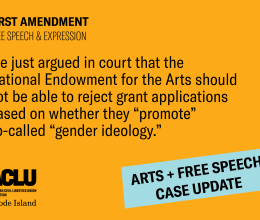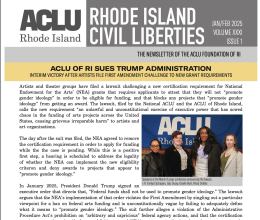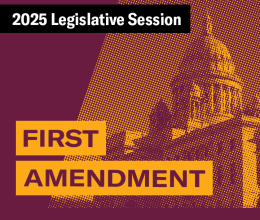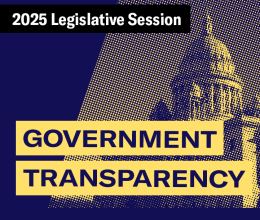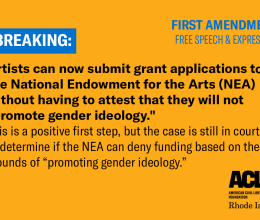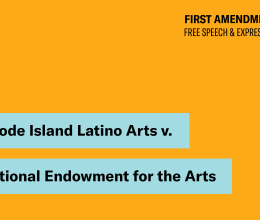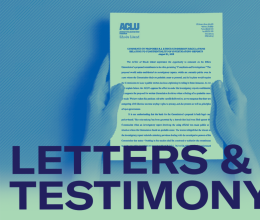The Rhode Island ACLU has filed a brief asking a federal judge to issue a permanent injunction requiring the City of Cranston to remove from public display a “School Prayer” mural addressed to “Our Heavenly Father” that is painted on a Cranston High School West auditorium wall. The brief was filed by RI ACLU volunteer attorneys Lynette Labinger and Thomas Bender in preparation for a court hearing on October 13th in the ACLU lawsuit, which had been filed in April. The suit is on behalf of Jessica Ahlquist, a sophomore at the school who, the brief notes, has been the subject of “personal attacks and intimidation” from students and others in the community ever since publicly opposing the display.
In a 63-page memo accompanying the request for an injunction, the ACLU argues that “both the purpose and effect of displaying the School Prayer is to communicate official approval of student prayer as part of the educational experience and tradition,” an action that is in direct violation of the First Amendment’s “Establishment Clause.”
Although school officials claim that the decision to continue the display of the prayer is in recognition of its “historical” value, the brief argues that the text of the display, the act of displaying it, its origins, and various school committee members’ contemporaneous public comments supporting the display “demonstrate that the only commonsense conclusion is that the March 2011 approval of the School Prayer display by the School Committee was for a predominantly, if not wholly, religious purpose – not a historical one.”
The ACLU’s brief also relies on events at the Bain Middle School to support its position that the continued display of the prayer is part of a broader effort by Cranston school officials to promote religion, not history. First, the brief points to a mandatory Memorial Day middle school assembly that takes place each year at Bain – including a ceremony that occurred after this lawsuit was filed – at which a Catholic priest delivers a prayer. The brief calls the event an example of the school district’s “approval and favor of incorporating elements of religious practice in public school programs.”
In a direct challenge to the City’s “history” rationale for maintaining the Cranston West prayer, the brief notes that a similar school prayer mural that had been on display in Bain’s auditorium for over seventy years was quietly removed after the ACLU’s lawsuit was filed, despite that display’s presumably even greater historical value .
Relying on numerous U.S. Supreme Court precedents, the brief argues:
For elementary and secondary public school students, whose attendance at school is mandatory, the Court has long recognized the special force of the indirect coercive pressure upon religious minorities to conform, when the prestige of government is placed behind a particular religious belief … For over 50 years the Court has applied [these] concerns … to consistently invalidate overt and implied messages of government endorsement of … prayer in public schools. . .
It has been a consistent position of the Court that even if schools do not actually impose pressure upon a student to participate in a religious activity, the Establishment Clause proscribes public schools from conveying or attempting to convey a message that religion or a particular religious belief is favored or preferred. The government-sanctioned permanent installation of Cranston West’s official “School Prayer” for its students does precisely that – it conveys the message that religious belief and prayer to “Our Heavenly Father” are integral to achieving the aspirations the students are asked to live up to as members of the Cranston West community and tradition. It conveys approval of the importance of religious belief and prayer, and the message that religious belief and prayer to “Our Heavenly Father” are, in the official school view, a vital part of becoming a good Cranston West citizen-student. From any objective perspective, that is the predominant, if not the sole, purpose and effect of displaying and continuing to display the School Prayer in the school auditorium.
Last July, after learning of the prayer mural, the ACLU wrote to school officials asking that it be removed. In the hope of avoiding litigation, the Affiliate and Ms. Ahlquist waited for the school committee to act. By a 4-3 vote in March, however, the school committee decided to keep the prayer, ignoring warnings about the cost of litigation and despite the school district’s ongoing and severe budgetary problems which have led to layoffs and program cuts. The Rev. Dr. Donald Anderson, executive minister of the R.I. State Council of Churches, and Rabbi Peter Stein, who leads a congregation in Cranston, have also expressed opposition to the display, calling it “inappropriate” and “exclusionary.”
The lawsuit notes that the prayer, which is at least eight feet high and three feet wide, “is designed to be easily read by students attending programs in the auditorium.” The lawsuit alleges that Jessica Ahlquist “does not subscribe to the religious expression conveyed by the prayer and objects to being subjected to it as a requirement of attending school and a condition of attending school programs in the auditorium.”
The suit notes that a number of speakers at public hearings identified the prayer’s religious message as the reason for urging the school committee to maintain it, and also expressed anger and outrage at people like Jessica who questioned the prayer’s display. In fact, a day after the school committee’s March vote, Jessica was allowed to leave class early in response to concerns for her safety arising out of her opposition to the prayer.
In May, the ACLU initially sought a preliminary injunction against display of the prayer, but the parties agreed to combine hearings on preliminary and permanent relief into one, leading to the October 13th hearing date.
The U.S. Supreme Court first ruled government-sponsored prayer in the public schools unconstitutional in 1962. Thirty years later, in a case from Rhode Island, the Supreme Court also ruled unconstitutional the recitation of prayers at public school graduation ceremonies.

